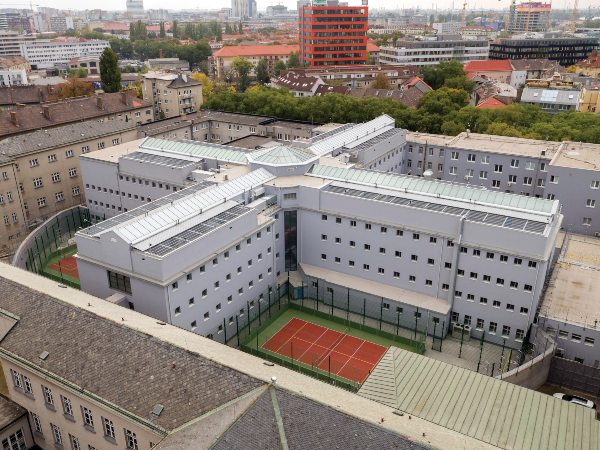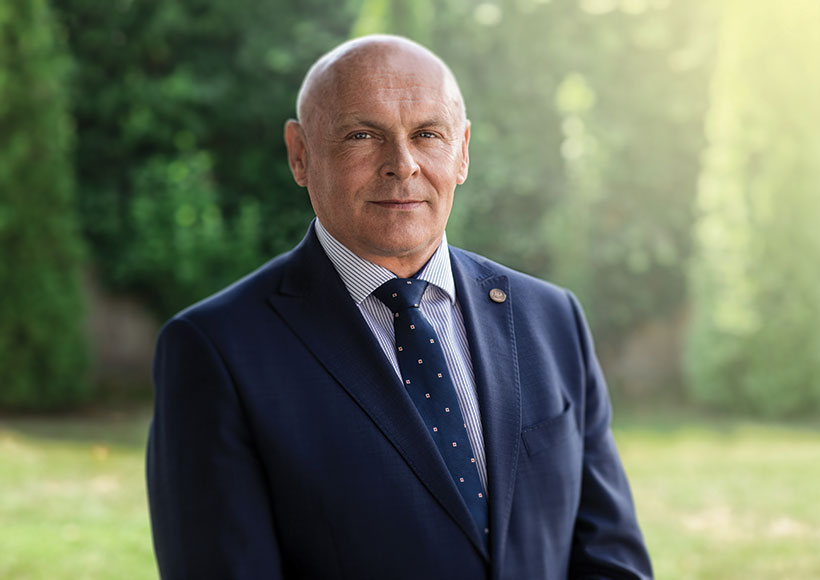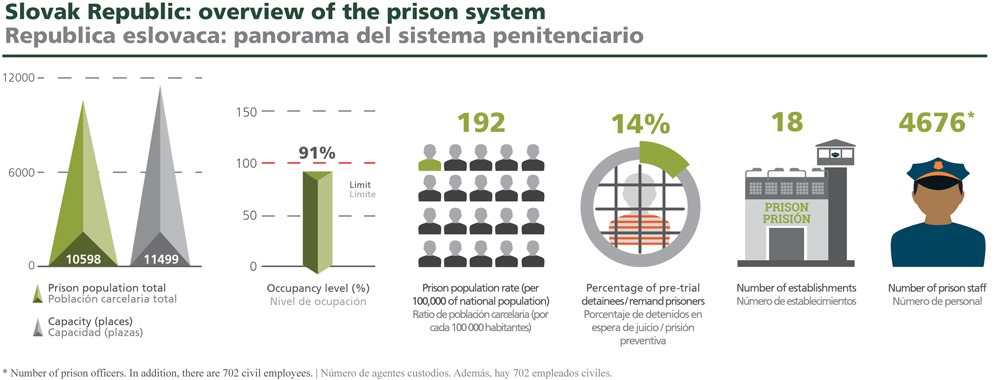// Interview: General Milan Ivan
Director-General of the Prison and Court Guards Corps, Slovakia
JT: What are the main challenges, but also the achievements of the Slovak prison system?
G.MI: The main challenges of the Slovak prison system are to build on the positive and good practices and achievements that we have already attained and, at the same time, to meet the expectations of modern society.
This year, we are commemorating the 50th anniversary of an independent penitentiary administration in Slovakia. I am convinced that the Slovak Prison Service has a renewed and successful history; we not only meet the most demanding conditions of this modern era, but we are also prepared for any upcoming developments.
In prison administration and operations, it is not just about using new knowledge and modern digital technologies. People remain the decisive factor. In our case we have educated, qualified and comprehensively prepared staff to create and maintain a humane and safe environment whilst ensuring the legal conditions for both pre-trial detention and prison term despite the markedly extended requirements in our correctional institutions.
A very current challenge, but also an ambition for the future, is to work with our staff in a more complex way, to ensure their proper training, skills and education, thus increasing their professionalism and readiness. The selection of new prison staff, their preparation, education and additional requirements must be in line with the demanding work nature of our service.
We are currently struggling with personnel recruitment issues, but also with the maintenance of prison staff, so we try to increase financial compensation and create better conditions for service performance. In order to optimise and stabilise our staff, we are increasingly dedicated to the human resources area, and we are trying to make the prison service more open to society also through cooperation with modern media and communication tools.
Our recruitment campaigns aim not only to raise awareness of our service social value and to achieve a more subjective picture of the prison system among the public but also to obtain young, educated, physically and psychically prepared people for the job. At the same time, we want to increase the recognition, self-esteem, and self-respect of prison staff.
We aim at further consolidating and modernising the prison system (…) gradually mitigating the consequences of insufficient funding in the past.
One of the Slovak prison system’s main objectives is to protect society against criminals and ensure legal conditions of pre-trial detention and prison term. At the same time, we develop programmes that contribute to the successful reintegration of incarcerated people, in compliance with the community’s needs and the recommendations of the European Prison Rules. Simultaneously, the treatment of inmates must be in line with the increase of static and dynamic security in our prisons.
Of course, we aim at further consolidating and modernising the prison system at the technical, infrastructure and security levels by exploiting available modern technologies, gradually mitigating the consequences of insufficient funding in the past. Simultaneously, we need to further improve the management and organisation of the prison service and all processes related to its activity, through the implementation of progressive working methods, handling prison operation and the cooperation with the external environment.
Along with the modernisation of the prison system, in order to achieve our objectives, we must create the necessary conditions which, among other things, are also related to finances. In addition to state budget resources, we are trying, in an effective and targeted way, to also use the financing of our projects from the European structural and investment funds or from other non-public resources.
As a good example, I would like to mention the “Chance for Return” project implemented within the EU Operational Programme “Human Resources”. This project connected our prison service to the Central Office of Labour, Social Affairs and Family, the social guardianship, the academy and the self-governing regions to obtain scientific knowledge and use it in the legislative changes that had been initiated, aiming to increase the effectiveness of prisoners’ re-socialisation. I am glad that this project is gradually expanding not only in extent but also in high added value.

JT: How do you address the overcrowding problem?
G.MI: One of our main aims is also to gradually decrease prison overcrowding. From 2015 to 2019, we succeeded in increasing the accommodation capacity by 197 places. In fact, from 2014 we have been preparing an extensive construction project of a new prison in south-eastern Slovakia, in Rimavská Sobota, where currently there is none. And, based on a government decision, we are preparing it as a new public-private partnership prison construction project.
The total planned capacity of this prison is 832 places, which will meet the European Prison Rules’ recommendations on the accommodation space of 4 m2 per prisoner. Presently, the potential applicants are being selected and public procurement for the concessionaire is ongoing; the project shall be implemented within three years and the estimated concession term is 20 years.
Furthermore, together with the Ministry of Justice, we are working to increase the effectiveness of electronic monitoring. In this regard, we are primarily responsible for preparing and processing proposals, in suitable cases, for the use of electronic monitoring; the decision on the conversion of the remainder of the prison sentence to house arrest is a responsibility of the courts.
Finally, the project preparation of the first psychiatric detention facility in Slovakia is ongoing, in cooperation with the Ministry of Health. This facility will be in southern Slovakia next to the psychiatric hospital in Hronovce. Prison staff of the nearby prison will be responsible for protection, some internal security and regime activities. Medical staff will oversee the detainees’ care. In this regard, together with the Ministry of Justice, we also take part in legislation preparation, namely a draft proposal that is currently being approved by the Parliament.
JT: A delegation of the Council of Europe’s Committee for the Prevention of Torture and Inhuman or Degrading Treatment or Punishment (CPT) carried out a periodic visit to the Slovak Republic, in March 2018.
The report of such visit has not been published yet, however, on the latest published report, referring to the 2013 visit, there were several recommendations, namely concerning the detention conditions – especially of life-sentenced prisoners and high-security ones – and the provision of healthcare in prisons (Source: CPT/Inf (2014) 29).
What is the state of affairs about the shortcomings/non-conformities pointed out by the CPT in the latest published report and what are the areas in which you believe the CPT will issue recommendations this time around?
G.MI: With regard to the last CPT visit report in 2013, we have applied the recommendations, for example by improving material and technical conditions in the prison system and observing the rights of the accused and convicted inmates, as well as those of the specific group of individuals serving life sentences and the dangerous offenders. We have improved the placement opportunities for this specific group, and we have also extended the scope of their rights in terms of visits and communication.
For us, the CPT representatives’ visits are a motivation for the future; however, each society has its own culture, specificities, and conditions, and the prison population is inseparably linked to them. Because of such specificities, it is not always possible to accord all conditions in the prison system with the vision of the CPT. Many good ideas of humanisation and further development of treatment of prison population are often bound to large financial resources, or to potential changes in legislation or prison staff approach.
Each legislative change of the conditions of liberty deprivation respects the CPT recommendations and tries to apply them systematically and as far as possible. Thus, our goal is to gradually grasp these ideas and then implement them in our conditions within the legal and real possibilities.
However, this should never be done at the expense of security and thus the basic mission of the prison system, which is to protect society against offenders, and at the same time to provide effective treatment aimed at their reintegration after serving their sentence. The preliminary version of the Slovak Government’s response to the last CPT visit report is currently being prepared.
We have successfully introduced a telephony system that uses new technologies, which has been a private investment. I am pleased to say that the mobile phone smuggling incidence in Slovakia’s prisons is minimal.
JT: What is the development status of alternative penal measures and community sentences in the Slovak Republic and what is their impact on the justice system and particularly the prison system?
G.MI: Slovakia has been actively and in the long term seeking a gradual development of alternative sanctions; however, its implementation is not within the competence of the prison system. In Slovakia, the competent authority responsible for imposing alternative sanctions is the court, whereas supervision of the execution of such sanctions is provided by the probation and mediation officers who work directly under the competence of the Ministry of Justice. Despite this, the Slovak Prison Service cooperates actively and closely with probation officers.
In recent years, Slovakia has expanded the scope of alternative sanctions, extended the technical and legislative preconditions for their imposing and the replacement of pre-trial detention. The possibility of conditional release was also extended to more serious crimes committed by convicts who had not been arrested before (first-time offenders).
Slovakia’s interest is to eliminate substantive and procedural barriers to alternative sanctions and to strengthen the confidence of the competent agencies in alternative sanctions, which should gradually result in the reduction of the prison population.

JT: To what extent is the use of technology and technological modernisation a reality in the Slovak prison system, and what are the advantages and challenges?
G.MI: We care about using new technologies in order to improve the security and comfort in the scope of the treatment of inmates. Although we have many deficits in this area, especially in the last five years we managed to gradually but fundamentally modernise the technologies of some prisons.
A very positive example is the complex prison reconstruction in the capital city, Bratislava, which integrated all modern technologies into an integrated and unified security system. We try to secure these modern technologies in other prisons as well, depending on the resources available, while we are trying to use the European Structural Funds, such as in the “Chance for Return” project.
In this regard, I would mention the extensive project “Effective Public Service and Integrated Infrastructure” that is planned for about three years by using the latest available technologies. We would like to gradually introduce this customer-oriented project in all Slovak prisons; it should improve the communication of prison staff with the inmates, improve the comfort of prison staff’s response to prisoners’ lives and needs, as well as enhance the safety of both prison staff and the inmates and at the same time the security of all our facilities.
Finally, the successful implementation of this project shall eliminate human error and will prevent undesirable situations, as most processes will be subject to complex optimisation and digitisation.
In addition, we have successfully introduced a telephony system that uses new technologies, which has been a private investment; I am pleased to say that the mobile phone smuggling incidence in Slovakia’s prisons is minimal.
We also use modern applications for collecting the data for purposes of service performance and management of the daily life and operation of our prisons. In this context, we focus on the coordination and unification of various applications and software programmes in order to use them more efficiently. This way, we have improved the management of the entire prison system.
The parameters and aims of the applications and technologies that are prepared, developed or tendered are coordinated not only with the Ministry of Justice and the Ministry of Interior, but also with the relevant Government projects and with the involved law enforcement authorities.
In terms of technological modernisation, the challenges of the prison service include the increasing safety risks, the very development and deployment of new technologies and their funding.
(…) the number of persons from these [organised criminal] groups in the prison population has increased dramatically.
JT: How are the issues of violent radicalisation and extremism, as well as organised crime, addressed in your prison system and to what extent does prison intelligence play a preponderant role in this matter?
G.MI: Fortunately, radicalisation and extremism don’t have a direct impact on Slovakia, nor on our prison system. Slovakia has a relatively low number of foreigners which also reflects in the prison population (approximately 2%). Indeed, at the same time, we record a few individuals who have been sentenced for terrorism and radicalisation related offences.
Of course, Slovakia has reacted to the potential threat of terrorism and radicalisation by various government decisions, while, in this regard, we monitor our area and we also cooperate with the relevant state agencies focusing on these threats. The Slovak Prison Service pays attention mainly to risk indicators connected with incarcerated persons, such as their behaviour, visits, and their communication such as telephone calls, correspondence and parcels. Furthermore, we are dedicated to the training and preparation of our staff, as well as mutual communication, and try to raise awareness within the service sections.
Organised crime is a completely different issue; thanks to relatively successful detection of such matters in the past years – by the relevant state agencies, such as police and prosecution, but also to the efficient cooperation with the Slovak Prison Service – the number of persons from these groups in the prison population has increased dramatically. This demands professional handling of differentiated pre-trial detention and prison term in our prisons by our staff, with a focus on their individual placement, enabling procedural acts and ensuring a smooth criminal investigation. In this respect, there is a cooperation and intensive exchange of information with other security forces in Slovakia.
//
General Milan Ivan successfully graduated from the Faculty of National Economy of the University of Economics in Bratislava. He has worked for the Slovak Prison Service (Prison and Court Guard Corps) since 2012, but previously he also worked for the Service from 1982 to 2008. He worked in various, mainly managerial positions in the area of economic activities in Želiezovce Prison, at the Headquarters of the Prison Service and Ministry of Justice of the Slovak Republic. He has served as the Director General of the Prison and Court Guard Corps since 2014. In May 2018, President of the Slovak Republic appointed him the rank General.
Advertisement




